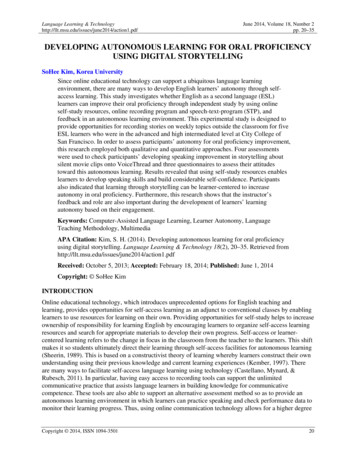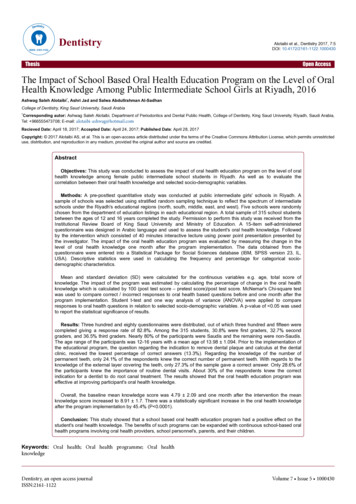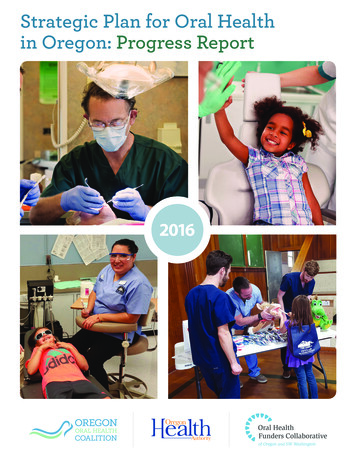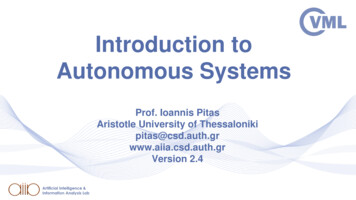
Transcription
Language Learning & n1.pdfJune 2014, Volume 18, Number 2pp. 20–35DEVELOPING AUTONOMOUS LEARNING FOR ORAL PROFICIENCYUSING DIGITAL STORYTELLINGSoHee Kim, Korea UniversitySince online educational technology can support a ubiquitous language learningenvironment, there are many ways to develop English learners’ autonomy through selfaccess learning. This study investigates whether English as a second language (ESL)learners can improve their oral proficiency through independent study by using onlineself-study resources, online recording program and speech-text-program (STP), andfeedback in an autonomous learning environment. This experimental study is designed toprovide opportunities for recording stories on weekly topics outside the classroom for fiveESL learners who were in the advanced and high intermediated level at City College ofSan Francisco. In order to assess participants’ autonomy for oral proficiency improvement,this research employed both qualitative and quantitative approaches. Four assessmentswere used to check participants’ developing speaking improvement in storytelling aboutsilent movie clips onto VoiceThread and three questionnaires to assess their attitudestoward this autonomous learning. Results revealed that using self-study resources enableslearners to develop speaking skills and build considerable self-confidence. Participantsalso indicated that learning through storytelling can be learner-centered to increaseautonomy in oral proficiency. Furthermore, this research shows that the instructor’sfeedback and role are also important during the development of learners’ learningautonomy based on their engagement.Keywords: Computer-Assisted Language Learning, Learner Autonomy, LanguageTeaching Methodology, MultimediaAPA Citation: Kim, S. H. (2014). Developing autonomous learning for oral proficiencyusing digital storytelling. Language Learning & Technology 18(2), 20–35. Retrieved Received: October 5, 2013; Accepted: February 18, 2014; Published: June 1, 2014Copyright: SoHee KimINTRODUCTIONOnline educational technology, which introduces unprecedented options for English teaching andlearning, provides opportunities for self-access learning as an adjunct to conventional classes by enablinglearners to use resources for learning on their own. Providing opportunities for self-study helps to increaseownership of responsibility for learning English by encouraging learners to organize self-access learningresources and search for appropriate materials to develop their own progress. Self-access or learnercentered learning refers to the change in focus in the classroom from the teacher to the learners. This shiftmakes it so students ultimately direct their learning through self-access facilities for autonomous learning(Sheerin, 1989). This is based on a constructivist theory of learning whereby learners construct their ownunderstanding using their previous knowledge and current learning experiences (Kember, 1997). Thereare many ways to facilitate self-access language learning using technology (Castellano, Mynard, &Rubesch, 2011). In particular, having easy access to recording tools can support the unlimitedcommunicative practice that assists language learners in building knowledge for communicativecompetence. These tools are also able to support an alternative assessment method so as to provide anautonomous learning environment in which learners can practice speaking and check performance data tomonitor their learning progress. Thus, using online communication technology allows for a higher degreeCopyright 2014, ISSN 1094-350120
SoHee KimDeveloping Autonomous Learning Using Digital Storytellingof learner independence in the teaching and learning of a second language (Stacke, 2007) since learnerscan maximize opportunities to practice. Moreover, second language learners need opportunities toproduce target language output, notice errors in their own output, and correct their linguistic output(Chapelle, 1998). Through self-evaluation, English learners can reflect on and critically evaluate theirown learning processes and performance; it encourages autonomy, increases motivation, promotespositive attitudes toward learning, and implies a new perspective regarding teachers’ and learners’ roles(Gonzalez & Louis, 2007, Hansen, 1998; O’Malley & Valdez Piere, 1996; Sinclair, 2000). Consideringthat the instructor can assess the learners’ oral performance and their completion of tasks within a specifictime period by analyzing collected data (Gonzalez & Louis, 2007; Jones, 2007), the instructor’s feedbackfacilitates learners’ progress towards attaining their own goals.This research explores how ESL learners’ oral proficiency changed through online recording tools andreceiving periodic feedback from their instructor outside the classroom over a 14-week period. There arefive ESL participants engaged in once-a-week recording, practicing, and listening to their recordings ofindividualized storytelling. They used an online recording program, Vocaroo, and a Text-to-Speech (TTS)program, vozMe, for the recordings; in order to receive feedback, they emailed the recordings to theirinstructor each week during the entire research period. To examine participants’ attitudes toward selfcentered learning using self-study resources for their oral proficiency development, three questionnaireswere conducted via online programs. Participants were prompted to recount stories after viewing fourCharlie Chaplin silent movie clips, uploaded onto VoiceThread, an interactive and multimedia onlineslide show program used to conduct assessments of their improvement in oral proficiency.This research aims to identify how their own independent learning, assessments, and feedback can helpfoster learners’ autonomy. It also attempts to address how ESL learners can develop their self-assessmentskills and how the teacher’s role can shift to facilitator or guide when self-study resources are used inautonomous learning.LITERATURE REVIEWDeveloping Autonomy Through Self-Assessment Using Self-Study ResourcesSignificant development of software and hardware has greatly expanded the range of speech technologiesavailable to students to improve their speaking abilities (Godwin-Jones, 2009). The technology can serveas a reporting medium for self-assessment through regular entries in self-evaluation of oral performancevia recording tools (Healey, 2007). Learners’ self-evaluation of their own linguistic competence canincrease active involvement in learning and become self-critical because self-monitoring strategies allowlearners to identify their own difficulties (Dam, 2000; Wenden, 1999). Thus, recording programs maybuild learners’ linguistic competence through their self-assessment. Through self-monitoring the use ofvoice e-mail can enhance learners’ pronunciation, grammar, and verbal expression for oral proficiencydevelopment as well as foster significant improvement in speaking relative to articulation and accuracy(Volle, 2005). VoiceThread can promote collaborative development of knowledge by giving learners theopportunity to share their voices (Brunvand & Byrd, 2011) with their peers and the instructor, making itso learners are able to monitor and assess not only their own learning progress but also their peers’performance. Video recording tools can also provide a valuable source of information for learners tonotice and analyze characteristics of their own speech (Lynch, 2007) to reflect on their learning progressbecause the learners can evaluate the full spectrum of their communicative performance (Oscarson, 1989).Autonomy depends on learners’ ability to self-direct for practice, critical reflection, and independentaction (Andrade, 2012; Little, 1991). From this perspective, awareness through self-assessment oflearners’ speaking performance and understanding their learning progress with self-study resources candevelop metacognitive skills to achieve their own learning goals, and ultimately this recursive process canenhance learners’ autonomy. However, learners may need guidelines to find appropriate resources toLanguage Learning & Technology21
SoHee KimDeveloping Autonomous Learning Using Digital Storytellingachieve their learning goals (Murray, 2005). In this research, participants used self-study resourcesprovided by the instructor, Vocaroo and vozMe, and then tried to pursue their own goals.In light of the role of self-assessment, using recording programs can be positively affecting specificlearning objectives for oral performance. However, researchers still need to define the optimal use ofautonomous learning for language learners’ speaking skills when using self-study resources.Digital Storytelling for Oral Proficiency Development and AssessmentLearners’ autonomy can be measured by their metacognitive awareness, ability to use resourcesappropriately, and assessing self-reflection of their development (Sinclair, 1999; Reinders & Lázaro,2007). In order to measure participants’ autonomy for oral proficiency development, this research useddigital storytelling with four silent movie clips uploaded onto VoiceThread to assess their independentstudy ability with self-assessment.Digital storytelling has been widely used to help learners communicate their own stories effectively sinceit can be a learner-centered activity when the topic is related to their daily life and personal subject matter.It can also have an impact on improving learners’ speaking in the narration process (Nelson, 2006),linguistic structure, vocabulary, sound patterns, and prosody of the foreign language (Verdugo &Belmonte, 2007). Learners can thus develop linguistic competence while describing context-rich visualsituations after repeating self-directed learning. In addition, using a silent movie clip helps to build themetacognitive knowledge involved in communication. Kasper and Singer (2001) claimed that since silentfilms do not offer preauthorized dialogue, learners are not only allowed, but also authorized to create theirown conversational texts, using English creatively to develop their own performance. Therefore,storytelling with a silent movie clip can be a good communicative competence task to measure Englishlearners’ oral proficiency in terms of functional and pragmatic knowledge from recorded files while theparticipants describe captured events and surrounding context (Kim & Choi, 2013; Kim, 2014).Along with the many studies that have examined the usefulness of digital storytelling in oral production,this research focuses on investigating how a learner can step forward in developing a new technique forassessing autonomy in oral proficiency using storytelling.RESEARCH QUESTIONSBased on a literature review and the underlying assumption that using self-study resources can greatlybenefit the development of English learners’ oral proficiency, the hypothesis of this study is thatparticipants’ oral proficiency can improve when using self-study resources and storytelling in anautonomous learning environment. This research was guided by the following questions:1) Does independent learning using Vocaroo, vozMe, and VoiceThread help to improve ESLlearners’ oral proficiency?2) Does using digital storytelling encourage ESL learners’ motivation and self-assessment of theirspeaking?METHODOLOGYParticipantsThe five participants (Table 1) attended a video ESL class at City College of San Francisco (CCSF). Fourof them were immigrants who had moved to the US within the previous three to 12 months, and one wasan international student who had been in the United States for a year and a half.Although they were high-level students and had studied English for at least five years in their nativecountries, they felt that they needed more speaking practice to improve their oral proficiency. AllLanguage Learning & Technology22
SoHee KimDeveloping Autonomous Learning Using Digital Storytellingparticipants had a computer with a microphone to record their stories at home as well as a positive attitudetoward learning English using self-study resources. Four participants used a computer every day, and onestudent used a computer two or three times a week.Table 1. Participants Profiles.ParticipantsNationalityAgeMonths livingin USYears wanese2712108*Note. ESL level 8 (advanced level) and ESL level 7 (high-intermediate level) at CCSFProceduresThis study used a learner-centered task—storytelling—to elicit participants’ oral production and increasetheir engagement with self-motivation to speak personally when given a specific topic through selfassessment opportunities. Nine different weekly topics were assigned pertaining to daily personal life orpreferences as a guideline to encourage practice and recording using the Vocaroo and vozMe programs.Since this research was designed for ESL learners to engage in activities outside the classroom, theparticipants recorded, practiced, or listened to their performance on their own time, accessing Vocaroo,vozMe, and their VoiceThread accounts (Figure 1). In order to determine how much time they spent onthese tasks as an indicator of progress, all participants listed the time for their recording, practice, andlistening when using two self-study resources, Vocaroo (http://www.vocaroo.com) and vozMe(http://vozMe.com/), on a Google Spreadsheet each week (Appendix A). Their documented record of timespent on independent study shows how much effort through time the participants spent on their ownlearning autonomously.The participants voluntarily emailed their recorded links once or twice a week using Vocaroo to theinstructor to receive feedback. Through these exchanges, the instructor was able to assess participants’learning progress, and participants were able to keep track of their learning history during the researchperiod. The instructor did not require that they submit their individual work, but instead encouraged themto engage in self-study and mediated the process of using self-study resources via email exchanged.Figure 1. Online self-study resources, Vocaroo, vozMe, and VoiceThread with a silent movie clip.In order to assess participants’ oral proficiency improvement, this research used storytelling task aboutLanguage Learning & Technology23
SoHee KimDeveloping Autonomous Learning Using Digital Storytellingsilent movie clips in weeks 1, 5, 10 and 14. The instructor uploaded the four movie clips onto herVoiceThread account (http://www.voicethread.com) and then invited all participants to watch them threedays before they were asked to create stories.All content in the four silent movie clips (Appendix B) from Charlie Chaplin’s movies (“CoffeeDrinking,” “Hotel Evergreen,” “The Kid,” and “City Lights”) was culturally non-controversial. Receivingthese movie clips via emails, the participants accessed their VoiceThread accounts and then recorded theirown stories about each movie clip. Each participant’s recording was shared with all participants as well asthe instructor; this meant that whenever participants recorded their stories onto VoiceThread, everyonereceived e-mails of those recordings. During this process, participants were able to monitor not only theirown but also their peers’ performance. Before recording their stories, the participants practiced speakingusing Vocaroo and vozMe, but they did not receive feedback for this assessment.Although the focus of this study was to examine ESL learners’ autonomous learning, it is important tonote that they were guided by their instructor on how to monitor their own speech and how to tell storieseffectively at the weekly meeting during the research period. The written feedback was given holistically,but the students also received feedback in each of four categories: discourse, pronunciation, vocabulary,and sentence complexity. The instructor also provided learning materials such as sentence combiningworksheets and vocabulary learning Web sites in order to prompt them to find appropriate answers whenneeded.The participants’ attitudes toward oral proficiency development for this learning method were alsoinvestigated using three questionnaires (Appendix C) conducted during weeks 1, 8, and 14. Theparticipants were asked to speak when responding to the first and the second questionnaires, which wereuploaded onto the instructor’s VoiceThread account. The first questionnaire documented the participants’language profile, computer skills, feelings about using a computer to study English speaking, and selfconfidence in their speaking. In the second questionnaire, participants expressed which speaking skillsthey wanted to improve as well as how their speaking confidence had changed using the self-studyresources–VoiceThread, Vocaroo, and vozMe. The final online survey asked participants to respond toquestions about motivation and self-assessment when using storytelling with silent movie clips, whetheror not the instructor’s role and feedback were helpful in their learning progress, if they thought usingVocaroo and vozMe could produce positive effects when they were assessed on VoiceThread, and finallywhich aspects of speaking they thought improved during this project.Data AnalysisThe recorded stories were assessed holistically and analytically. The holistic rubric (Appendix D) wasadapted from Brown’s (2001) oral proficiency scoring categories, divided into five stages: (1) beginningspeaking, (2) developing speaking, (3) competence speaking, (4) accomplished speaking, and (5)advanced speaking. To analyze their improvement in each element of speaking skills, the recorded fileswere also analyzed in five categories (Appendix E) adapted from a scoring key created by Choi (2005),based on the communicative language ability (CLA) model offered in Bachman and Palmer (1996). Thefive categories are: pronunciation, discourse, vocabulary, grammar, and sentence complexity. Eachcategory has scores from 1 to 5.Two trained raters assessed the recorded data (Appendix F) using the rubrics. The inter-rater reliability oftwo raters was Cohen’s Kappa .88 and the reliability among the four assessments presents a high level ofconsistency, Cronbach’s Alpha 0.83.RESULTSOral Proficiency Improvement Using Self-Study ResourcesData analysis of the four assessments revealed significant improvement in all participants’ overallLanguage Learning & Technology24
SoHee KimDeveloping Autonomous Learning Using Digital Storytellingproficiency in terms of vocabulary, sentence complexity, and pronunciation, but there was no significantimprovement in discourse and grammar (Table 2).Table 2. Oral Proficiency Improvement for All Participants.95% Confidence IntervalSDLowerUppertSignificantOverall 99Vocabulary.447-1.755-.645-6.000.004Sentence complexity.548-2.080-.720-5.715.005Note. Grammar cannot be computed because SE is 0, Significant at the 0.05 levelUnderlying these results was recording stories using online recording and a TTS program can improveESL learners’ oral proficiency. In addition, storytelling seems to support the use of rich vocabulary wordsto describe the given topics or contextualized situations appropriately and develops sentence complexitythrough their own speech monitoring and feedback. However, most participants had organized story linesto offer enough information about what they have seen from the movie clips for each assessment sincethey had practiced how to create organized stories on each weekly recording. Considering that nofeedback on grammar was given on the holistic rubric, participants’ grammar scores may have beenaffected by feedback. This finding suggests that instructor feedback is important in improving theirspeaking skills, even in autonomous learning. In addition, participants’ overall oral proficiency wasgradually enhanced during the four assessments: their speaking significantly improved when comparingthe first and fourth assessment over 13 weeks (Table 3). This result may also confirm that using self-studyresources can develop ESL learners’ speaking.Table 3. Paired t-Test for Oral Proficiency Improvement on each Assessment.95% Confidence IntervalTest # / Pair differencesMeanSDLowerUppertSignificant1. 1st vs. 2nd2.80.548-1.080.280-1.633.1782. 2nd vs. 3rd3.20.447-.755.355-1.000.3743. 3rd vs. 4th3.40.548-1.280.080-2.499.0704. 1st vs. 4th4.00.447-1.755-.645-6.000.004Note. Grammar cannot be computed because SE is 0, Significant at the 0.05 levelParticipants also had positive attitudes toward using Vocaroo and VozMe to make progress in theirspeaking. Tran, who had practiced and recorded using these programs, had the most improvement inspeaking during the 14 weeks. In his first assessment he lacked confidence and repeated the samevocabulary, used simple sentences without many embedded clauses, and mispronounced words makinghis speaking unclear. However, his speaking improved significantly in sentence complexity, vocabulary,grammar, discourse, and pronunciation. Although Li’s overall speaking also advanced in sentencecomplexity, grammar, vocabulary, and discourse, he showed no progress in his pronunciation in terms ofword stress and intonation. He often used Vocaroo to record his speaking, but he only used vozMe fourLanguage Learning & Technology25
SoHee KimDeveloping Autonomous Learning Using Digital Storytellingtimes since he felt it was not helpful. In the case of Luc, his overall speaking improved, but grammar anddiscourse scores remained the same. Yu’s overall oral proficiency also developed slightly. Hwang, despiteusing the computer less than the others and logging in the least amount of times, showed growth in herspeaking. Interestingly, all participants began to speak more confidently by using various expressions andmaking longer sentences after using self-study resources and felt using these could produce a positivelearning effect for increasing their self-confidence as highlighted in their answers to the questionnaire.In the three questionnaires, Tran and Li responded that they could increase their working vocabulary byrecording stories. Yu thought recording programs helped her pronunciation. Luc replied that he used morecomplex sentences and that this learning technique could help vocabulary and pronunciation through selfassessment. Hwang reported that she felt recording programs were good pronunciation practice tools.These results, reported on the second questionnaire, almost align with the speaking skills that they soughtto develop through this learning: Tran, Li, and Luc hoped to improve their vocabulary ability, Hwangaimed to use more complex sentences, and Yu wanted to develop her pronunciation.Participants were also satisfied with this self-learning method because they could check and assess theirspeaking after listening to their own recordings. Li responded that using self-study resources motivatedhim to practice because it helped build confidence due to the self-reflective learning process. Yuanswered that this autonomous learning was very flexible and convenient since she could record herspeaking many times as well as monitor it, thus helping to improve her speaking. However, Li and Luchad negative attitudes about using the vozMe program since they thought that it could not produce clearand natural sounds like a real person, which made them have difficulty mimicking pronunciation. Luc andTran also suggested that this learning could have produced more positive effects if they could have had aconversation with a real person such as a native speaker while using this self-learning method. Forexample, in the case of one participant, Hwang, whose husband’s first language is English, thought thislearning method gave her a good opportunity to strengthen her oral proficiency. Luc also preferredspeaking with a native speaker because he was able to improve his listening skills as well as he receivingimmediate feedback. Tran responded that this learning style is good but felt more comfortable whenhaving a conversation with a person. Hwang and Yu did not express any negative feelings about this typeof learning.Digital Storytelling for Motivation and Self-AssessmentThis research used storytelling to encourage ESL learners’ involvement in recording their speaking. Sincestorytelling can serve to create natural discourse as a narrative task when language learners produce theirown ideas or events, as a learning method, it enables good self-assessment as well as building selfconfidence. Most participants responded that creating stories encourages self-reflection and increasestheir motivation to practice speaking about their preferences or daily lives. Through storytelling,participants felt that they were able to enhance their speaking ability because it required improvingsummarizing as it related to the narration process, learning more vocabulary, making longer sentences,and improving pronunciation. During this process, they were also able to build self-confidence as reportedin their questionnaires.Regarding the use of multimedia materials, the participants also mentioned that the silent movie clipswere helpful as a prompt to practice their speaking. Participants reported in the questionnaire that usingsilent movie clips for storytelling encouraged them to create their own stories and to clarify their chosenwords as they described the movie clip. Although these assessments were used to check participants’ oralproficiency, they responded that it was a learner-centered learning since participants recorded stories andmonitored their progress using self-study resources for their own purposes during the four assessmentsperiods. In the same vein, they also felt that these assessments were not only an extension of their ongoingindependent study but also provided opportunities for receiving feedback from the instructor in order toachieve their mutually agreed upon learning goals for oral proficiency development. Moreover, theyLanguage Learning & Technology26
SoHee KimDeveloping Autonomous Learning Using Digital Storytellingreported that using VoiceThread for storytelling supported collaborative work in that they could monitortheir peers’ performance as well as self-monitor their speaking progress on their own accounts during thefour assessments.DISCUSSIONThis empirical study took into account how ESL learners were able to develop personal speechmonitoring skills and learn speech-improvement strategies by using self-study resources with storytellingand feedback in an autonomous environment. Among the study results, one important finding asserts thatself-assessment, motivation, and feedback play significant roles when using self-study resources todevelop their oral proficiency. Self-assessment allows learners to monitor their level of success of specifictasks through a reflective process. In line with this, Tholin (2007) argued that self-assessment is a naturalelement of self-directed learning and learners need to be conscious to make choices that contribute todeveloping their language abilities. Through this self-monitoring process, learners can gradually speakmore fluently after reflecting on their errors, and then can apply this kind of self-reflection to their classesor in their real lives. Using VoiceThread to record one’s own story also allows for self-evaluation, whichencourages students’ autonomy through active engagement. This study also shows that a TTS program,vozMe, may help ESL learners’ oral production in terms of vocabulary, sentence complexity, andpronunciation.Kolb’s cyclical reflective model (Figure 2) explains participants’ self-reflection process to increase theiroral proficiency development.Figure 2. Kolb’s cyclical reflective modelIn the first concrete experience stage, participants were motivated to increase their speaking practice andrecording with weekly topics using self-study resources, Vocaroo and vozMe, through the instructor’sencouragement and guidance in developing speaking skills. In the second reflective observation stage,they monitored and corrected their performance through the instructor’s feedback and repeated practice,recording, and listening. In the third abstract conceptualisation stage, participants were excited aboutpracticing and monitoring themselves to improve their speaking with feedback and learning resourcesthrough their self-assessment. In the final stage of testing in new situations, participants tried out whatthey had learned through an assessment for storytelling with a silent movie clip. During this process,participants were able to build metacognitive skills to achieve their learning goals. In this stage, theparticipants also could evaluate their own speaking as well as that of their peers. Throughout onereflective cycle, which includes four stages, participants’ oral proficiency has the potential to graduallydevelop by repeating this learning process while going through each of the four assessments.Language Learning & Technology27
SoHee KimDeveloping Autonomous Learning Using Digital StorytellingCONCLUSIONThis research set out to discover whether autonomous learning to support an infinite learning opportunitywithout time and space constraints can help to improve English oral proficiency by using online selfstudy programs for high-intermediate and advanced ESL learners. Although this is an ESL context inwhich the participants may have had many speaking opportunities other than simply practicing theirspeaking using self-study resources, I found that all participants developed their oral proficiency andgained self-confidence through self-assessment by recording their stories. This indicates that using acombination of communication tools—namely, Vocaroo, vozMe, and VoiceThread—gives ESL learnersa positive
Since online educational technology can support a ubiquitous language learning environment, there are many ways to develop English learners' autonomy through self-access learning. This study investigates whether English as a second language (ESL) learners can improve their oral proficiency through independent study by using online











